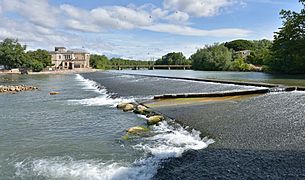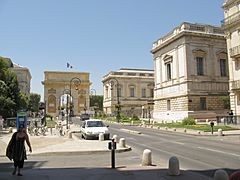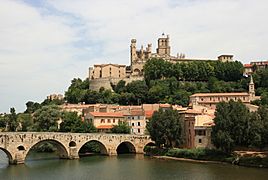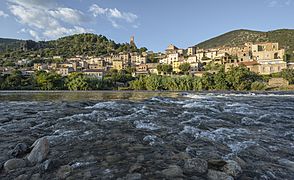Hérault facts for kids
Quick facts for kids
Hérault
|
|||
|---|---|---|---|
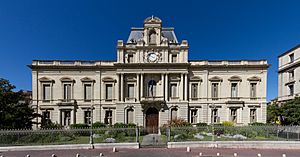
Prefecture building of the Hérault department, in Montpellier
|
|||
|
|||
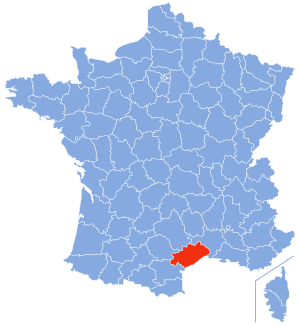
Location of Hérault in France
|
|||
| Country | France | ||
| Region | Occitanie | ||
| Prefecture | Montpellier | ||
| Subprefectures | Béziers Lodève |
||
| Area | |||
| • Total | 6,101 km2 (2,356 sq mi) | ||
| Population
(2014)
|
|||
| • Total | 1,107,398 | ||
| • Rank | 21st | ||
| • Density | 181.511/km2 (470.11/sq mi) | ||
| Demonym(s) | Héraultais | ||
| Time zone | UTC+1 (CET) | ||
| • Summer (DST) | UTC+2 (CEST) | ||
| ISO 3166 code | FR-34 | ||
| Arrondissements | 3 | ||
| Cantons | 25 | ||
| Communes | 343 | ||
| Website | http://www.herault.fr/ | ||
Hérault (Occitan: Erau) is a department in the region of Occitanie in southern France. It is named after the Hérault river.
The inhabitants of Hérault are known, in French, as Héraultais (women: Héraultaises).
Contents
History
Hérault was created in 1790 during the French Revolution, when the whole of France was divided into departments, replacing the old provinces. Aude was formed with part of the old province of Languedoc.
It was divided in four districts: Montpellier, Béziers, Lodève and Saint-Pons, with Montpellier as is capital.
In 1800, with the creation of the arrondissements in France, the four districts were changed into four arrondissements. On 10 September 1926, the arrondissements of Lodève and Saint-Pons were eliminated but on 1 June 1942 Lodève became again an arrondissement.
Geography
Hérault has an area of 6,101 km2 (2,356 sq mi). It is surrounded by the departments of Aude, Aveyron, Tarn, and Gard, with the Gulf of Lion (Mediterranean Sea) to the east and southeast.
 |
Aveyron (Occitanie) |
Gard (Occitanie) |
 |
|
| Tarn (Occitanie) |
Mediterranean Sea | |||
| Aude (Occitanie) |
Mediterranean Sea |
The main rivers in the department are the Orb and the Hérault which gives its name to the department.
Climate
The climate in Montpellier, in the northeast of the department near the Mediterranean coast, is a Mediterranean climate, a "dry-summer subtropical" climate, Csa in the Köppen climate classification.
The average amount of precipitation for the year in Montpellier is 629.9 mm (24.8 in). The month with the most precipitation on average is October with 96.5 mm (3.8 in) of precipitation. The month with the least precipitation on average is July with an average of 15.2 mm (0.6 in). There are an average of 73.4 days of precipitation, with the most precipitation occurring in December with 9.2 days and the least precipitation occurring in July with 2.3 days.
The average temperature for the year in Montpellier is 15.1 °C (59.2 °F). The warmest month, on average, is July with an average temperature of 24.1 °C (75.4 °F). The coolest month on average is January, with an average temperature of 7.2 °C (45.0 °F).
Administration
The département is managed by the Departamental Council of the Hérault in Montpellier. Hérault is part of the region of Occitanie.
Administrative divisions
There are 3 arrondissements (districts), 25 cantons and 343 communes (municipalities) in Hérault.
| INSEE code |
Arrondissement | Capital | Population (2014) |
Area (km²) |
Density (Inh./km²) |
Communes |
|---|---|---|---|---|---|---|
| 341 | Béziers | Béziers | 312,443 | 2,986.8 | 104.6 | 152 |
| 342 | Lodève | Lodève | 94,714 | 1,819.6 | 52.1 | 98 |
| 343 | Montpellier | Montpellier | 700,241 | 1,294.6 | 540.9 | 93 |
The following is a list of the 25 cantons of the Hérault department (with their INSEE codes), following the French canton reorganisation which came into effect in March 2015:
- Agde (3401)
- Béziers-1 (3402)
- Béziers-2 (3403)
- Béziers-3 (3404)
- Cazouls-lès-Béziers (3405)
- Clermont-l'Hérault (3406)
- Le Crès (3407)
- Frontignan (3408)
- Gignac (3409)
- Lattes (3410)
- Lodève (3411)
- Lunel (3412)
- Mauguio (3413)
- Mèze (3414)
- Montpellier-1 (3415)
- Montpellier-2 (3416)
- Montpellier-3 (3417)
- Montpellier-4 (3418)
- Montpellier-5 (3419)
- Montpellier - Castelnau-le-Lez (3420)
- Pézenas (3421)
- Pignan (3422)
- Saint-Gély-du-Fesc (3423)
- Saint-Pons-de-Thomières (3424)
- Sète (3425)
Demographics
The Hérault department has a population, in 2014, of 1,107,398, for a population density of 181.5 inhabitants/km2. The arrondissement of Montpellier, with 700,241 inhabitants, is by far the largest. The other two arrondissements, Béziers and Lodève, have respectively 312,443 and 94,714 inhabitants.
Evolution of the population in Hérault
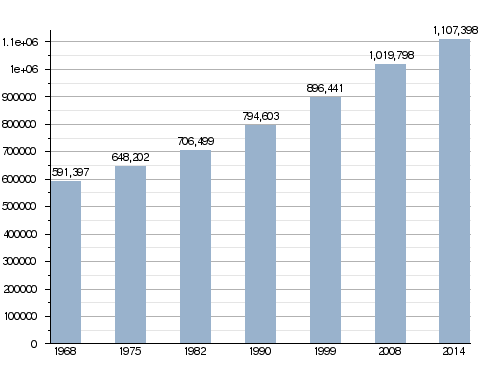
The communes in the department with more of 10,000 inhabitants are:
| City | Population (2014) |
Arrondissement |
|---|---|---|
| Montpellier | 275,318 | Montpellier |
| Béziers | 75,701 | Béziers |
| Sète | 44,136 | Montpellier |
| Agde | 26,111 | Béziers |
| Lunel | 24,873 | Montpellier |
| Frontignan | 22,896 | Montpellier |
| Castelnau-le-Lezl | 19,157 | Montpellier |
| Mauguio | 16,765 | Montpellier |
| Lattes | 15,963 | Montpellier |
| Mèze | 11,196 | Montpellier |
Gallery
-
The Hérault river at Agde
-
Porte du Peyrou in Montpellier
Related pages
Images for kids
-
Montpellier's FISE in 2013
-
Tamburello's match in Notre-Dame-de-Londres
-
Promenade du Peyrou in Montpellier
-
Crique de l'Anau in Sète
See also
 In Spanish: Hérault para niños
In Spanish: Hérault para niños




